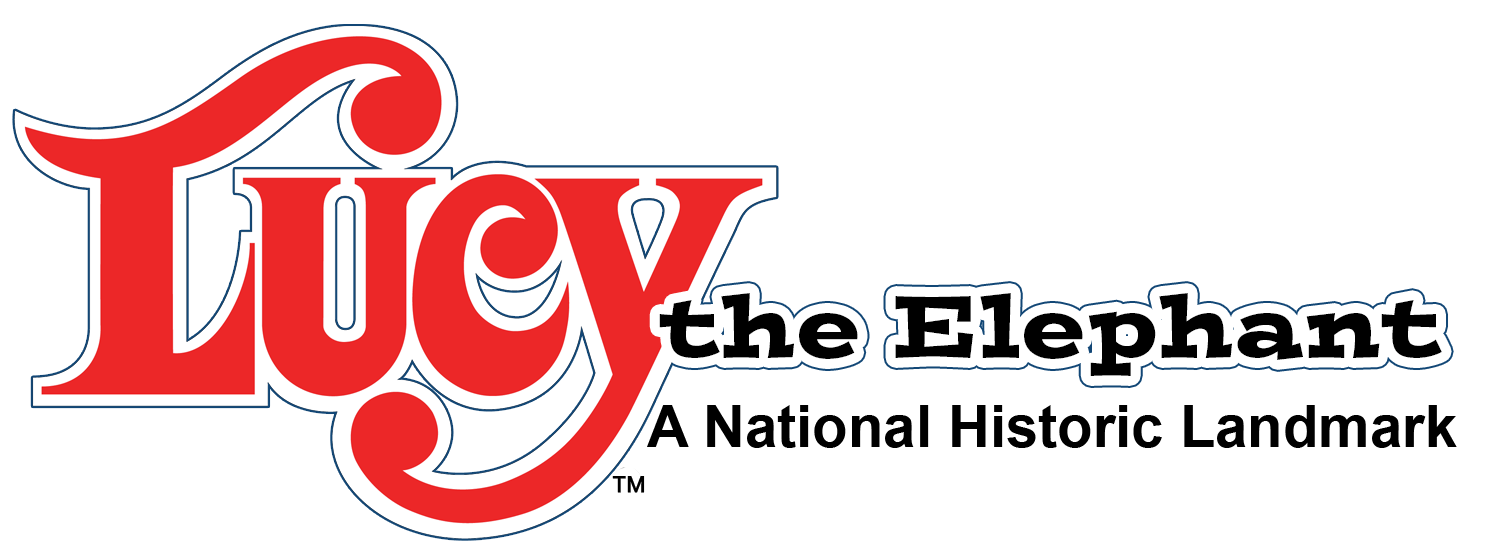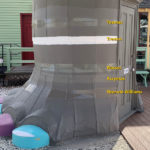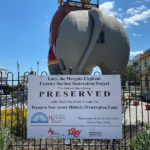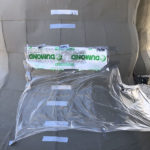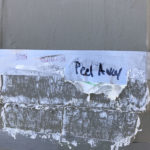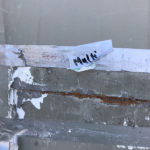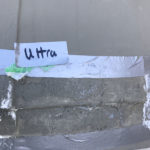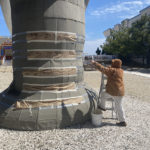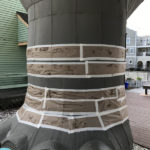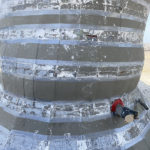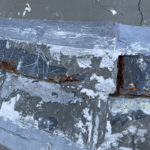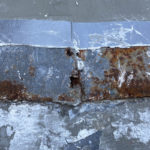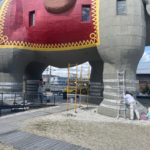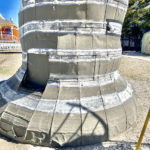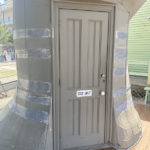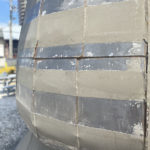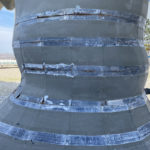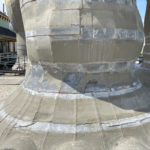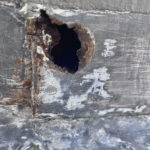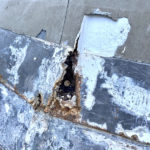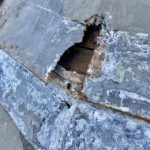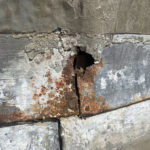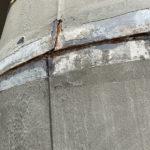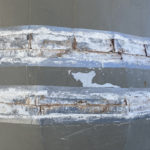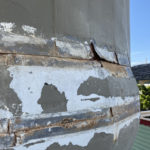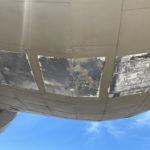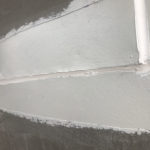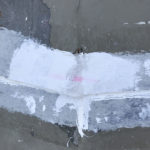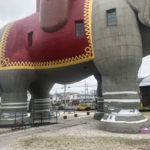Now you see her… now you don’t.
On September 20th, Lucy will disappear behind weatherproof scaffolding and not be visible to visitors for approximately 9 months. The Save Lucy Committee is about to embark on the largest restoration effort of the famous National Historic Landmark since she was saved from the wrecking ball in 1970. Lucy’s entire metal skin surface is going to be replaced with all new metal. More than 50% of her skin has deteriorated beyond repair. After careful analysis by Lucy’s restoration architect, Margaret Westfield of Westfield Architects and Preservation Consultants of Haddon Heights, NJ, along with metallurgist, Scott Kreilick of Kreilick Conservators, they have determined that replacing her metal skin would be more cost effective than trying to remove the 50 years of paint and rust.
The last day to tour Lucy will be Sunday, September 19th, from 10am to 5pm. On Monday, September 20th, the historic landmark and America’s Oldest Roadside Attraction will close to the public. The target date to re-open Lucy is Memorial Day weekend of 2022. Lucy’s Gift Shop will remain OPEN during this project with access through the historic train station door on Atlantic Avenue.
The Challenge to Preserve Lucy
Originally named Elephant Bazaar, this ninety-ton, six-story, elephant-shaped building was built in 1881 by Philadelphia-born James Vincent de Paul Lafferty, Jr. in hopes of selling parcels of land located near the beach in South Atlantic City, the area now known as Margate City, NJ. Constructed of wood covered in tin cladding, this example of novelty architecture originally served as a real estate office followed by many other business ventures throughout her history.
Despite being located just a few hundred feet from the Atlantic Ocean, Lucy the Elephant was never designed to withstand the harsh environment associated with seaside living; however, this amazing building has stood the test of time surviving hurricanes and lightning strikes, amongst numerous other disasters.
As part of their ongoing challenge to preserve Lucy the Elephant, one of the biggest threats faced by the Save Lucy Committee is water. Being a wooden structure covered in sheets of tin metal, the only line of protection against rust is a thin layer of paint that has been applied every 4-5 years since 1970.
Unfortunately, this paint layer has been ineffective in preventing rust from continuing to form on the metal — so much so, that areas of the metal have rusted completely through, leaving holes that expose the wooden framing underneath to water that is infiltrating the structure. This can be evidenced by stains on the interior plaster walls. If not addressed soon, the water will cause significant damage to the historic landmark.
After applying an expert-recommended chemical paint removal product, the testing panels were wrapped in paper for a 24-hour dwell time before attempting to remove paint from Lucy’s legs.
In response, the Save Lucy Committee is following expert recommendations to remove all of the existing paint layers on the structure down to the bare metal, and then make any necessary repairs to the metal and seams before applying a new high-tech coating system in hopes of resolving this issue.
To accomplish this task, the Save Lucy Committee began a two-phase project in March 2020, with the first phase primarily being a discovery phase designed to test the effectiveness of various stripping products for removing the paint from Lucy’s skin. At this same time, various paint coating systems would be tested for their effectiveness as well.
Based on the results of their findings, the best performing products will be selected and used on the entire elephant structure in Phase 2 of this important restoration project.
Testing panels after one application of a chemical stripping product. More applications would be necessary to remove all of the paint down to the bare metal.
Phase 1: Discovery
As part of Phase 1, five testing panels that wrapped around each of Lucy’s legs were created to test five expert-recommended paint coating systems with varying exposures. For these samples to properly adhere, though, almost 50 years of paint would need to be removed to expose the bare metal. Various chemical stripping products were tested, and after numerous applications we quickly realized that removing the paint was not going to be an easy task. Even more troubling, removing the many layers of paint revealed extensive damage to much of the existing metal skin covering Lucy. This unfortunate discovery means that repairing the metal is no longer an option. It was now necessary to replace all of the metal covering Lucy the Elephant before any repainting of the 140-year-old historic landmark could begin.
One of several holes that were discovered in the metal “skin” during the paint removal process. In this image, the wooden sheathing is exposed to the elements, leading to water infiltration and damage to the wooden structure.
To test the various coating systems, each testing panel on Lucy’s legs were painted with one of the five expert-recommended products from Tnemec, Tremco, Wasser, Acrymax, and Sherwin Williams. The samples now had to be put to the test, withstanding the harsh seaside environment for a period of twelve months before being evaluated by a paint analyst to determine the best performing product to be used when repainting the entire elephant in Phase 2.
Placement diagram of the five expert-recommended paint coating system samples on Lucy’s legs.
Phase 2: Construction
After waiting one full year, it was now time to evaluate our paint samples created in Phase 1 of the project. Which coating system performed the best? Carefully examining each of our samples for adhesion, color retention, sheen, texture, rust inhibitive properties, and other factors; the paint coating system that performed the best was the Acrymax system which will be used when repainting Lucy the Elephant.
Now that the coating system has been chosen, the Save Lucy Committee had one more difficult decision to make. The type of metal used to cover Lucy the Elephant is no longer produced, so a new metal must be chosen that will be able to withstand the harsh seaside environment where Lucy resides while respecting Lucy’s historic fabric — tin. Of the options presented to the Committee by its metallurgist, one metal alloy stood out ahead of the rest due to its excellent corrosion resistance in marine applications, its malleability, and its strength.
The Cleveland Clinic DOME Theatre at the Great Lakes Science Center with a closer look detailing the panels of Monel 400 that cover the exterior of the domed structure.
Monel 400, a nickel-copper alloy, will be used to cover Lucy and hopefully allow the historic structure to survive another 140 years and beyond, with our favorite pachyderm joining other amazing structures such as the Cleveland Clinic DOME Theater and the Guardian Building, a National Historic Landmark located in Detroit, Michigan.
The cost to complete Phase 2 of this restoration project is approximately $1.9 MILLION! While that’s a lot of money, we think Lucy is worth every penny! With your support, a little bit of luck, and a lot of “know-how”, this new high-tech approach will be the ultimate deterrent in the fight against water entering Lucy the Elephant.
WE NEED YOUR HELP!
This project is being supported in part by a Historic Preservation Fund grant administered by the National Park Service, Department of the Interior as well as a capital grant from the Preserve New Jersey Historic Preservation Fund, administered by the New Jersey Historic Trust. The Save Lucy Committee, Inc. also received an operating support grant through the New Jersey Historical Commission, a division of the Department of State.
Any amount you can donate will help preserve Lucy’s legacy!
For those wishing to donate by check, please write Lucy’s Life Preservers in the memo and make payable to Save Lucy Committee, Inc.
View Our Progress

